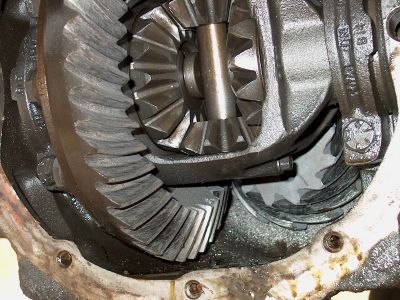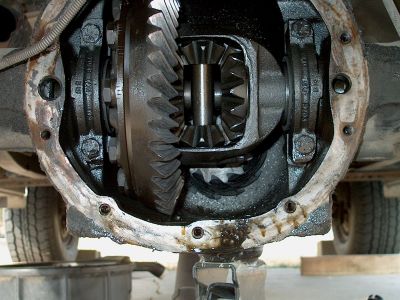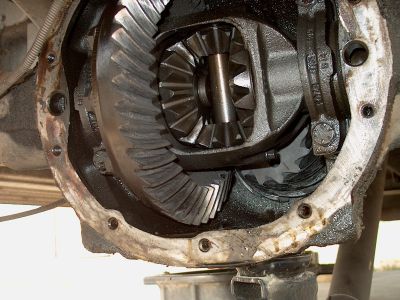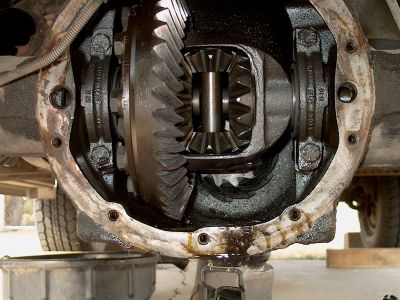Welcome back:
I believe this is what you need. Take a look through it and let me know. The attached pictures correlate with the directions.
__________________________________________
Adjustment
1. Install pinion bearing races in housing using a suitable driver.
2. Lubricate pinion bearings and install bearings in races.
3. Mount depth gauging jig in housing, Fig. 8, noting the following:
a. Assemble gauge plate onto preload stud.
B. Hold pinion bearings in position, insert stud through rear bearing and pilot and front bearing and pilot, then install retaining nut and tighten nut until snug.
C. Rotate tool to ensure bearings are properly seated.
D. Hold preload stud and tighten nut until 20 inch lbs. Of torque, which is required to rotate stud. To prevent damage to bearing, tighten nut in small increments, checking rotating torque after each adjustment.
E. Mount side bearing discs on arbor, using step for disc that corresponds to base of housing.
F. Mount arbor and plunger assembly in housing, ensuring side bearing discs are properly seated, install bearing caps and tighten cap bolts to prevent bearing discs from moving, Fig. 9.
4. Mount dial indicator on arbor stud with indicator contact button bearing against top of arbor plunger.
5. Preload indicator 3/4 revolution and secure to arbor mounting stud in this position.
6. Place arbor plunger on gauge plate, rotating plate as needed so that plunger rests directly on button corresponding to ring gear size.
7. Slowly rock plunger rod back and forth across button while observing dial indicator.
8. At point on button where indicator registers greatest deflection, zero dial indicator. Perform steps 7 and 8 several times to ensure correct setting.
9. Once verified zero reading is obtained, swing plunger aside until it is clear of gauge plate button and record dial indicator reading. Indicator will now read required pinion depth shim thickness for a ``nominal'' pinion.
10. Inspect rear face of drive pinion to be installed for a pinion code number. This number indicates in thousandths of an inch necessary modification of pinion shim thickness obtained in step 9.
11. Select pinion depth adjusting shim as follows:
a. If pinion is stamped with a plus (+) number, add that number of thousandths to dimension obtained in step 9.
B. If pinion is stamped with a minus ( - ) number, subtract that many thousandths from dimension obtained in step 9.
C. If pinion is not stamped with plus or minus number, dimension obtained in step 9 is correct shim thickness.
12. Remove gauging tools and pinion bearings from housing, noting installation position of bearings.
Installation
1. Install selected shim onto pinion shaft, lubricate rear pinion bearing with specified axle lubricant, then press rear bearing onto pinion using suitable spacers.
2. Install new collapsible spacer onto pinion shaft, then insert pinion assembly into housing.
3. Lubricate front pinion bearing, install bearing into housing and tap bearing over pinion shaft with a drift while assistant holds pinion in place. Old pinion nut and a large washer can be used to seat front bearing on pinion, but care must be taken not to collapse spacer if this method is used.
4. Install new pinion seal in housing, coat seal lips with grease, then mount driveshaft yoke on pinion shaft, lightly tapping yoke until several pinion shaft threads protrude from yoke.
5. Coat rear of pinion washer with suitable sealer, then install washer and new pinion nut.
6. Hold driveshaft yoke with suitable tool, then alternately tighten pinion nut and rotate pinion until endplay is reduced to zero.
7. When endplay is reduced to zero, check pinion bearing preload using a torque wrench.
8. Continue tightening pinion nut in small increments until 35-40 inch lbs. Of bearing preload is obtained with new bearings or 20-25 inch lbs. Of bearing preload is obtained with used bearings, rotating pinion and checking preload after each adjustment. Exceeding preload specification will compress collapsible spacer too far, requiring replacement of spacer. If preload specification is exceeded, spacer must be replaced and adjustment procedure must be repeated. Do not loosen pinion nut to reduce preload.
Take care,
Joe
Images (Click to make bigger)
Friday, May 14th, 2021 AT 12:26 PM
(Merged)






